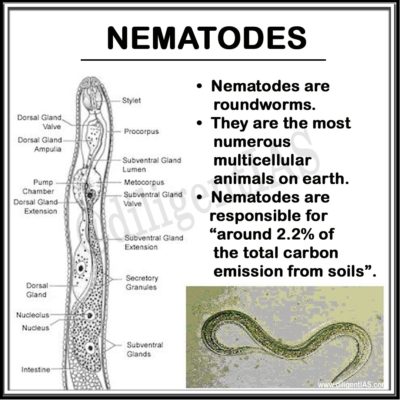First global analysis of soil worms or nematodes – Diligent IAS 13/08/2019 – Posted in: Daily News – Tags: soilworms
NEMATODES
A group of more than 50 researchers gathered more than 6,500 soil samples from each of the seven mainlands of the world (seven continents) and found that there are around 57 billion nematodes for each person on Earth.
- It is the first global analysis of nematodes.
What are Nematodes?
Nematodes are roundworms and their size can vary from a tiny 0.2 millimetre to a few metres. They are the most numerous multicellular animals on earth. Nematodes are structurally simple organisms.
Nematodes that feed on bacteria, fungi, and other nematodes, yet the vast majority of species encountered are poorly understood biologically.
Key findings
- Nematodes are responsible for “around 2.2% of the total carbon emission from soils”.
- Sub-Arctic regions have the highest (38% of total) abundance of nematodes.
- The temperate region has the next highest abundance followed by the tropical regions.
Why the worms preferred the cold regions?
The soil organic matter content was the key driver for nematode abundance. The low temperature and high moisture in the sub-Arctic regions reduce the decomposition rate of organic matter. This leads to the accumulation of organic matter and the nematodes happily thrive on them.
Indian Soils
- Soils from Western and Eastern Ghats of India and the Himalayas were used for the study. Soils samples were also used which was collected from all parts of India in the past 50 years.
- These nematodes play a crucial role in the environment as they are responsible for production of about 19% of ammonia of the soil.
- They are also important bioindicators of soil ecosystem health.
- Various kinds of bacteria, fungi, arthropods and a wide variety of nematodes inhabit the soil.
Threats
- Many nematicides have been indiscriminately used in agricultural fields, posing a major threat to their survival.
- We need the use of biological control methods to save these important organisms.
Way ahead
- Predicting climate change requires that we comprehend global carbon and nutrient cycles. We at present have an extraordinary comprehension of the physics and chemistry of our planet, however, we know far less about the natural life forms or biological organisms that drive these cycles.
- Improving our understanding of these organisms at a worldwide level is critical if we are going to understand and address environmental/climate change.
- We can study the environmental changes by looking at a small amount of soil as they can represent the entire food web.
Source: The Hindu
Also, read more daily News
- Pradhan Mantri Kisan Urja Suraksha evam Utthaan Mahabhiyan (PM-Kusum)
- Gogabeel lake is Bihar’s first community reserve
- New GDP series to align with Global Method
- Lake “Kajin Sara”
- Reusable Rockets
- Henley Passport Index 2019
You are on the Best Online IAS preparation platform. You are learning under experts.
We are present on Facebook- Diligent IAS, LinkedIn- Diligent IAS, YouTube- Diligent IAS, Instagram- Diligent IAS. Get in touch with us

